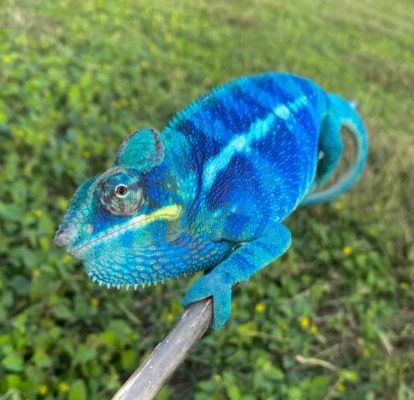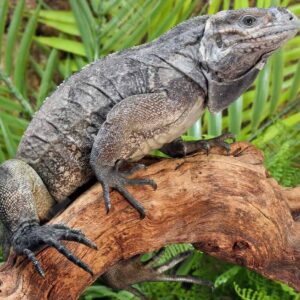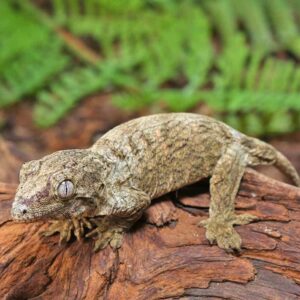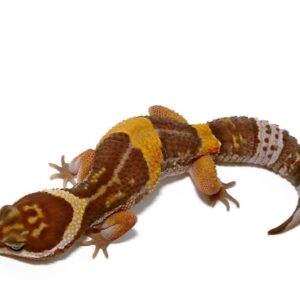Nosy Be Panther Chameleon For Sale
$399.99
WE HAVE NOSY BE PANTHER CHAMELEON FOR SALE. HERE ARE SOME HIGHLIGHTS:
- Furcifer pardalis
- Captive Bred
- Approximate Sizes Ranging From 9 – 12 Inches Length
- Adults Are Averaging Around 12 – 18 Inches In Total Length
- Feeding On Vitamin Dusted Crickets, Worms And Roaches
FUN FACTS!!
- This Is One Of The Most Popular Species Of Chameleons Due To Their Extreme Coloration
- Male Chameleons Display More Vibrant Colors Than Females
- Originating From Madagascar These Are Found On Nosy Be Island
- Arboreal Species, Provide Plenty Of Fake Plants And Branches
- A Misting Or Dripping System For Water Is Best, Manual Misting Also Works
- With Proper Care They Can Live Up To 3 – 5 Years In Captivity
Description
The Nosy Be Panther Chameleon (Furcifer pardalis) is a captivating reptile native to the island of Nosy Be, situated off the northwest coast of Madagascar. This species is widely celebrated for its extraordinary color variations that exhibit a stunning palette of blues, greens, and reds, making it one of the most visually striking chameleons. The brilliance of these colors is not only a marvel to behold but also plays a vital role in communication and mating rituals.
Distinguished by its vibrant appearance, the Nosy Be Panther Chameleon possesses unique physical traits that set it apart from other chameleon species. One of the most notable features is its ability to change color, which is facilitated by specialized cells called chromatophores. These cells allow the chameleon to adjust its pigmentation in response to environmental factors, emotional states, and interactions with other chameleons.
The Nosy Be Panther Chameleon typically inhabits the lush, tropical rainforests of Nosy Be, where it thrives in the humid, warm climate. Adapted to an arboreal lifestyle, this chameleon excels in navigating the dense foliage, using its prehensile tail and zygodactylous feet to maintain balance and agility among the branches. It primarily feeds on insects, employing its long, sticky tongue to catch prey with remarkable precision.
In addition to its vibrant coloration and arboreal abilities, the Nosy Be Panther Chameleon exhibits a range of fascinating behaviors. Males are particularly territorial and will display intense coloration to ward off rivals or attract potential mates. These displays are not only a testament to their beauty but also a crucial aspect of their social interactions and reproductive success.
Overall, the Nosy Be Panther Chameleon is a remarkable example of the diversity and wonder of Madagascar’s wildlife. Its unique characteristics and behaviors make it a subject of great interest for herpetologists and reptile enthusiasts alike, setting the stage for a deeper exploration into the life and ecology of this magnificent species.
Habitat and Distribution
The Nosy Be Panther Chameleon, scientifically known as Furcifer pardalis, is native to the island of Nosy Be, situated off the northwest coast of Madagascar. This island presents an ideal environment for the chameleon’s survival and proliferation due to its unique tropical climate and rich biodiversity. The island’s conditions are characterized by a warm, humid climate with a distinct wet and dry season, providing a balanced ecosystem that supports a wide variety of flora and fauna.
Nosy Be’s tropical rainforest is abundant with lush vegetation, dense foliage, and a variety of tree species that offer the perfect habitat for the Nosy Be Panther Chameleon. These chameleons are arboreal, meaning they spend most of their lives in the trees, where they can camouflage seamlessly within the green canopy. The chameleons’ vivid coloration is not only a means of camouflage but also serves as a communication tool amongst themselves, making the dense, vibrant forest an essential component of their habitat.
The ecological conditions of Nosy Be are particularly conducive to the chameleon’s needs. The island’s high humidity levels, frequent rainfall, and warm temperatures create an environment where the chameleon’s primary food sources, such as insects and small invertebrates, are abundant. The vegetation provides ample hiding spots and hunting grounds, ensuring that the chameleon can thrive and maintain a balanced diet.
Moreover, the island’s relatively stable and unspoiled ecosystem, with minimal human interference, has allowed the Nosy Be Panther Chameleon to flourish. Conservation efforts and the natural isolation of Nosy Be have helped preserve this unique environment, ensuring that the chameleons continue to thrive in their natural habitat. This delicate balance of climate, vegetation, and ecological conditions makes Nosy Be an exemplary home for the Nosy Be Panther Chameleon, highlighting the importance of preserving such pristine habitats for future generations.
Physical Characteristics and Coloration
The Nosy Be Panther Chameleon, a subspecies of the Panther Chameleon, exhibits a remarkable array of physical characteristics that distinguish it from other reptiles. Typically, this chameleon measures between 12 to 20 inches in length, with males generally being larger and more robust than females. Their body structure is notably adapted for an arboreal lifestyle, featuring zygodactylous feet, which are divided into two groups of opposing digits, providing a strong grip on branches. Additionally, their prehensile tails aid in maintaining balance and stability as they navigate through their forested habitats.
One of the most captivating aspects of the Nosy Be Panther Chameleon is its vibrant coloration. Predominantly, these chameleons display a dazzling palette of blues and greens, which can range from deep turquoise to vivid emerald. This coloration is not just for show; it plays a crucial role in their survival and social interactions. The remarkable ability to change color is facilitated by specialized cells called chromatophores, which expand or contract to alter the pigmentation of the chameleon’s skin.
Color change in the Nosy Be Panther Chameleon serves multiple purposes. Primarily, it acts as a form of communication. For instance, males often exhibit brighter and more intense colors when asserting dominance or during courtship displays to attract females. Conversely, more subdued hues may indicate submission or a non-threatening presence. Another vital function of this dynamic coloration is camouflage. By adjusting their color to blend with the surrounding foliage, these chameleons can effectively evade predators and ambush prey.
Overall, the physical characteristics and coloration of the Nosy Be Panther Chameleon are not only visually striking but also essential to their behavior and ecological interactions. This remarkable adaptability highlights the intricate balance of form and function in the natural world.
Diet and Feeding Habits
The Nosy Be Panther Chameleon, a captivating reptile endemic to the island of Nosy Be in Madagascar, has a diet primarily composed of a variety of insects and small invertebrates. These chameleons exhibit a predatory nature, using their remarkable tongue to capture prey with precision. Their diet includes crickets, locusts, and various species of worms, which supply the necessary nutrients to maintain their vibrant coloration and overall health.
In their natural habitat, Nosy Be Panther Chameleons exhibit a keen ability to hunt. They employ their exceptional eyesight to spot prey from considerable distances. Once located, the chameleon uses its elongated, sticky tongue to snatch the insect with lightning speed. This feeding behavior is not only efficient but also vital for their survival in the wild, where food availability can vary.
Feeding habits in captivity should mimic their natural diet as closely as possible to ensure optimal health. A varied diet is crucial for captive chameleons to prevent nutritional deficiencies. In addition to crickets and worms, it is beneficial to introduce other insects like roaches and flies. Occasional supplementation with calcium and vitamins is recommended to support bone health and overall well-being.
It is important to note that hydration plays a significant role in the diet of the Nosy Be Panther Chameleon. In the wild, they often drink water droplets from leaves after rainfall. In captivity, providing a consistent water source through misting or drip systems helps to replicate their natural environment and prevent dehydration.
Overall, the diet and feeding habits of the Nosy Be Panther Chameleon are intrinsically linked to their health and longevity. Whether in the wild or captivity, a well-balanced and varied diet ensures these fascinating creatures thrive, showcasing their stunning colors and unique behaviors.
Behavior and Social Structure
The Nosy Be Panther Chameleon exhibits a fascinating array of behaviors, characterized by its territorial nature and complex social interactions. These chameleons are predominantly solitary creatures, fiercely defending their territories from intruders. Males are particularly territorial, displaying vivid color changes and aggressive postures to ward off other males. This territorial behavior ensures that each chameleon has access to sufficient resources such as food, basking spots, and shelter.
Mating rituals of the Nosy Be Panther Chameleon are equally intriguing. During the breeding season, males exhibit even more vibrant colors to attract females. The courtship process involves a series of displays, including head bobbing and body inflation. If the female is receptive, she will allow the male to approach and mate. Post-mating, females typically become more reclusive, seeking out secure locations to lay their eggs.
Interactions with other chameleons are generally limited to these territorial and mating encounters. Outside of these periods, Nosy Be Panther Chameleons prefer to remain solitary, minimizing contact with others of their kind. This solitude is a survival strategy, reducing competition for resources and the risk of predation.
In terms of daily activities, Nosy Be Panther Chameleons follow a routine that includes basking, hunting, and resting. Basking in the sunlight is crucial for thermoregulation, enabling these ectothermic creatures to maintain optimal body temperatures. Hunting activities are characterized by their stealth and precision, as they rely on their excellent camouflage and rapid tongue projection to capture prey. Resting periods are typically spent in well-concealed spots, where they remain motionless and blend into their surroundings to avoid detection by predators.
Overall, the behavior and social structure of the Nosy Be Panther Chameleon are shaped by their need for territory, successful reproduction, and survival in the wild. These aspects collectively highlight the adaptability and fascinating nature of this remarkable species.
Reproduction and Lifecycle
The reproduction and lifecycle of the Nosy Be Panther Chameleon provide a captivating glimpse into the intricacies of nature. Courtship behaviors in these chameleons are particularly fascinating. Males display vibrant colors and engage in ritualistic movements to attract females. This visual spectacle is not only a testament to their beauty but also a critical component of their mating process. The male’s coloration becomes even more vivid during this period, serving both as a signal to potential mates and a deterrent to rival males.
Once a female consents, mating takes place, typically lasting a few minutes. After mating, the female embarks on the egg-laying process. She will seek out a suitable site, often digging a small hole in the soil where she can deposit her eggs. The number of eggs laid can vary but generally ranges between 10 to 40. After laying the eggs, the female covers them with soil, ensuring they are well-hidden and protected.
The incubation period for Nosy Be Panther Chameleon eggs is significantly influenced by environmental conditions, especially temperature and humidity. On average, it takes around 6 to 12 months for the eggs to hatch. During this period, the eggs are susceptible to various factors, making the choice of nesting site crucial for the survival of the offspring.
Upon hatching, the young chameleons, known as hatchlings, begin their journey towards adulthood. Hatchlings are remarkably self-sufficient, exhibiting instinctual behaviors that aid in their survival. They are capable of hunting small insects and navigating their environment with minimal parental guidance. As they grow, they undergo several molts, shedding their skin to accommodate their increasing size. This process continues until they reach full maturity, typically around 12 to 18 months.
The lifecycle of the Nosy Be Panther Chameleon, from courtship to adulthood, is a testament to the resilience and adaptability of this remarkable species. Each stage, from the vibrant courtship displays to the meticulous egg-laying and the developmental milestones of the hatchlings, underscores the complexity and beauty of their existence.
Conservation Status and Threats
The Nosy Be Panther Chameleon, a captivating species endemic to the island of Nosy Be in Madagascar, currently faces several conservation challenges. Classified as “Near Threatened” by the International Union for Conservation of Nature (IUCN), the Nosy Be Panther Chameleon is vulnerable to a range of threats that jeopardize its survival in the wild.
One of the principal threats to the Nosy Be Panther Chameleon is habitat destruction. The rapid deforestation on Nosy Be Island, driven by agricultural expansion, logging, and infrastructure development, has led to significant loss of natural habitats. These activities fragment the chameleon’s habitat, reducing the available space for foraging, breeding, and shelter, thus impacting their overall population.
Another pressing threat is the illegal pet trade. The Nosy Be Panther Chameleon’s striking coloration and unique appearance make it a highly sought-after species in the exotic pet market. Unsustainable collection practices for international trade can severely deplete local populations, further endangering the species. Despite regulations under the Convention on International Trade in Endangered Species of Wild Fauna and Flora (CITES), illegal trading persists, exacerbating the chameleon’s decline.
Conservation organizations are actively working to mitigate these threats and promote the survival of the Nosy Be Panther Chameleon. Efforts include habitat restoration projects that aim to reforest areas and establish protected reserves on Nosy Be Island. Additionally, community-based initiatives are being implemented to educate local populations about the importance of conserving the chameleon’s habitat and reducing deforestation.
Anti-poaching and monitoring programs are also vital components of conservation strategies. By strengthening enforcement of wildlife trade laws and conducting regular population assessments, conservationists strive to curb the illegal pet trade and ensure the long-term viability of the species.
Through a combination of habitat preservation, community engagement, and stringent enforcement of wildlife protection laws, the continued survival of the Nosy Be Panther Chameleon can be supported, thereby maintaining the ecological balance and biodiversity of Nosy Be Island.
Caring for Nosy Be Panther Chameleons in Captivity
Nosy Be Panther Chameleons, renowned for their vibrant colors and distinct patterns, require specific care to thrive in captivity. A well-set-up habitat is crucial for their well-being. An appropriately sized enclosure, generally a vertical terrarium measuring at least 18 x 18 x 36 inches, is recommended to provide ample space for climbing. Inside the enclosure, include branches, live plants, and foliage to mimic their natural environment, which not only offers hiding spots but also aids in humidity retention.
Maintaining the right environmental conditions is paramount. A temperature gradient should be established, with a basking spot of around 85-90°F and a cooler area of 70-75°F. Nighttime temperatures should drop to around 65-70°F. Humidity levels should be kept between 50-70%, which can be achieved through regular misting and the use of a hygrometer to monitor levels. UVB lighting is essential for chameleons to synthesize vitamin D3 and should be provided for 10-12 hours a day.
Diet is another critical aspect of care. Nosy Be Panther Chameleons are primarily insectivores, thriving on a diet of crickets, dubia roaches, and occasional waxworms or silkworms. It’s important to gut-load these insects with nutritious foods and dust them with calcium and vitamin supplements to prevent deficiencies. Fresh water should be available through misting or a drip system, as chameleons often prefer to drink from water droplets on leaves.
Health care involves regular observation for signs of illness, such as changes in appetite, coloration, or behavior. Regular veterinary check-ups can help detect and prevent common health issues, including metabolic bone disease and respiratory infections. Handling should be minimized to reduce stress; chameleons generally do not enjoy being handled and can become distressed.
Ethical considerations are vital when keeping these creatures in captivity. Potential owners should ensure they are sourcing their chameleons from reputable breeders to avoid contributing to the illegal wildlife trade. Commitment to providing a suitable environment and proper care is essential to the well-being of Nosy Be Panther Chameleons in captivity.






